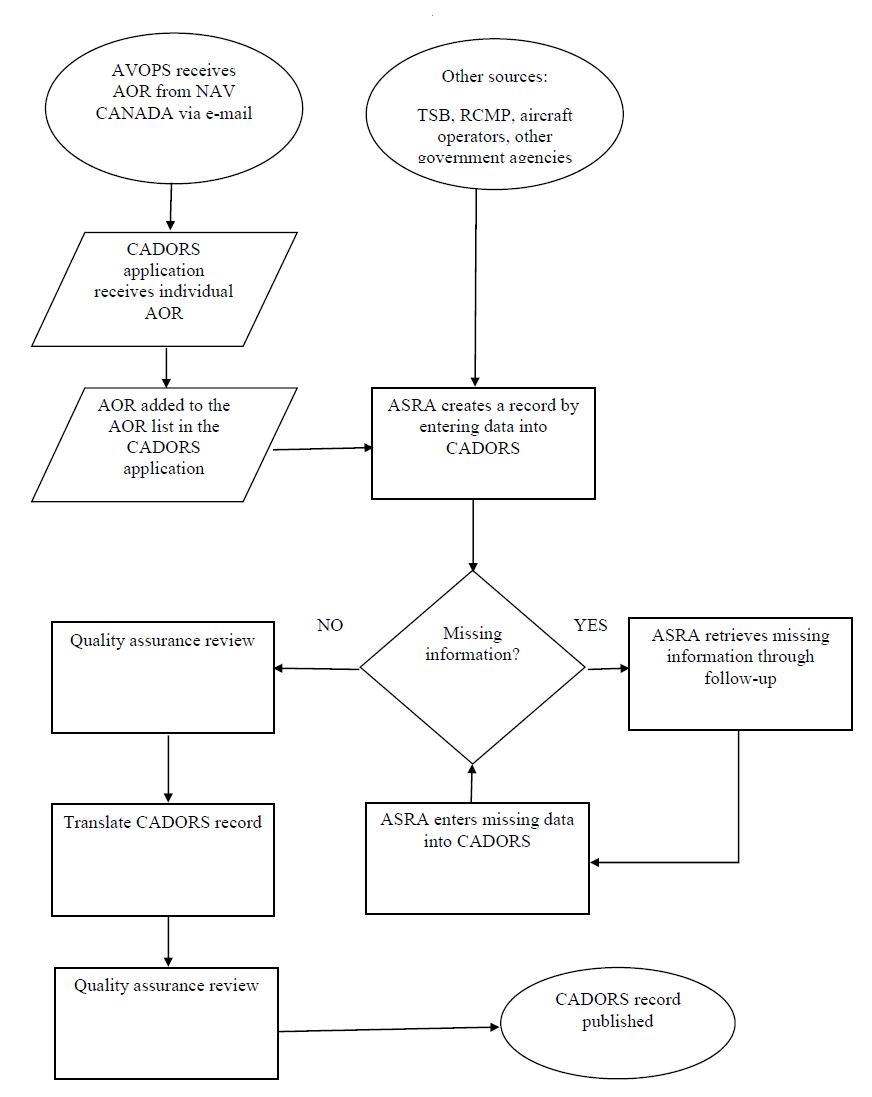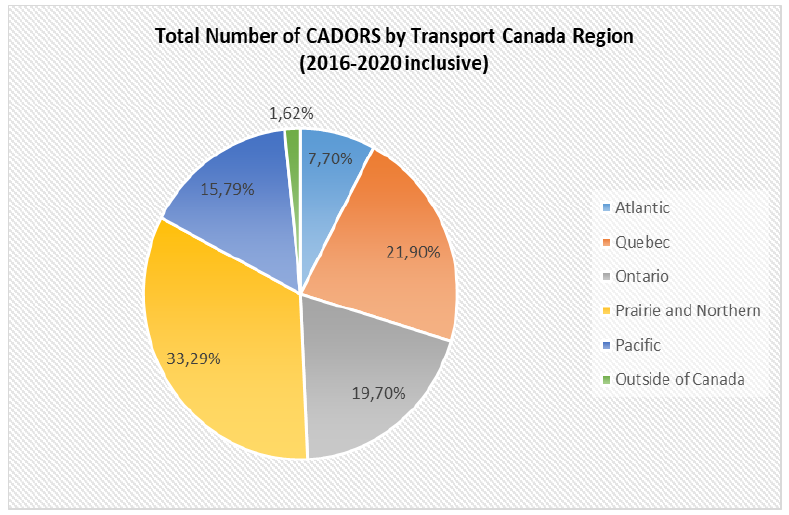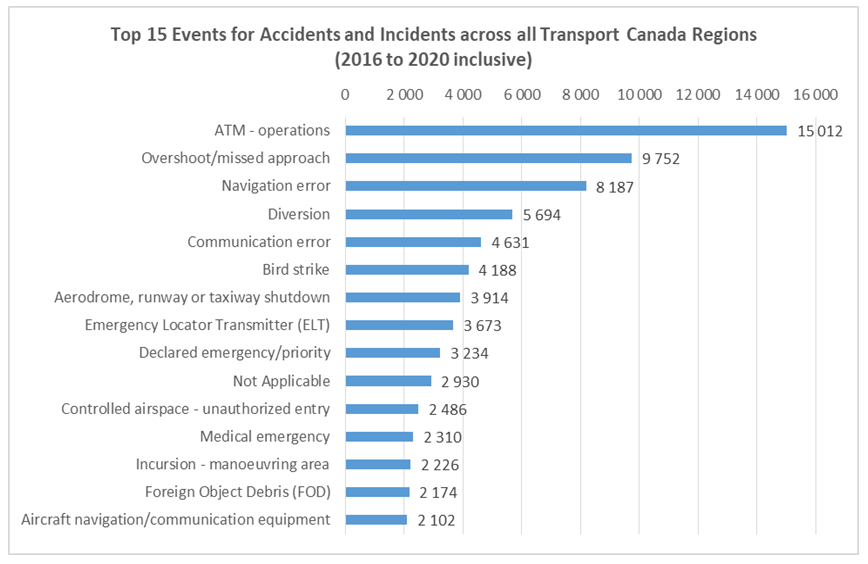Sherry Reid, Manager, Aviation Safety Research and Analysis, Transport Canada
Why CADORS?
Good safety information is key to the continuous improvement of aviation safety. As the main source of aviation occurrence information in Canada, the Civil Aviation Daily Occurrence Reporting System (CADORS) is an invaluable aviation safety tool.
Over the last five years, Transport Canada Civil Aviation (TCCA) has received an average of 16 750 aviation incident and accident reports annually—that is roughly 45 per day! CADORS collects and tracks the details of each occurrence and the information is used by stakeholders inside and outside TCCA to identify and monitor safety issues.
Launched in 1985, CADORS was created to provide timely information about civil aviation occurrences. It is also used to capture information that Air Traffic Services (ATS) operations certificate holders are required to report under Canadian Aviation Regulations (CARs), section 807.01.
There is a lot of value in collecting aviation occurrence information. Occurrence reporting and incident follow-up ensures that:
- TCCA has a record of civil aviation occurrences that is as accurate as possible and up to date;
- Civil aviation stakeholders are notified of occurrences;
- Underlying hazards in the aviation system are identified; and
- Occurrences are evaluated to identify the underlying factors that need to be addressed in order to eliminate or mitigate risks, thus maintaining aviation safety.
How is the information used?
The information gathered in CADORS is often used in the early identification of potential hazards and system deficiencies, and in the assessment of associated risks. CADORS data is further used by TCCA personnel and external stakeholders to follow up on specific events, develop safety communications, and develop reports and studies on potential safety issues.
Where does the information come from?
NAV CANADA provides about 80% of aviation occurrence information used to create a CADORS record. That information is provided in an aviation occurrence report (AOR). Other sources of information used to create a CADORS record may come from the Transportation Safety Board (TSB), Royal Canadian Mounted Police (RCMP), aircraft operators, and other government agencies.
NAV CANADA sends AORs to Transport Canada Aviation Operations (AVOPS) via e-mail. The CADORS application receives the individual AOR and adds it to the AOR list where Aviation Safety Research and Analysis (ASRA) staff enter the data into CADORS to create a record. ASRA retrieves missing information by consulting multiple sources. A quality assurance review is performed prior to the record being translated and finally published. The flowchart in Figure 1 outlines this process. Although CADORS data is considered preliminary, it is updated as required to include additional information or corrections.
ASRA is in the process of updating its CADORS manual to include current information on the criteria and reporting procedures for reporting an aviation occurrence as per section 807.01 of the CARs.
What does CADORS tell us? A snapshot of high-level event data
Regional analysis
Analyzing CADORS data helps us identify where aviation incidents and accidents are happening.
Between 2016 and 2020, approximately one-third of aviation incidents and accidents reported in CADORS occurred in the Prairie and Northern Region (comprising Manitoba, Saskatchewan, Alberta, Nunavut, Northwest Territories and Yukon), while Quebec and Ontario Regions accounted for almost 55% of occurrences. Atlantic region accounted for 7.70% and Pacific region for 15.79%. Incidents and accidents outside of Canada accounted for 1.62%.
Event analysis
Analysts assign one or more events to each CADORS record based on the details of that occurrence. Events can describe something that happened to an aircraft (e.g. hard landing, diversion, navigation error, etc.) or something that happened within the aviation system (e.g. aerodrome, runway or taxiway shutdown, foreign object debris, etc.), and provide a short description of what happened during an occurrence.
Assigning an event or events to a record helps to categorize occurrences in CADORS and improves our ability to analyze data. Analyzing events allows us to perform immediate follow-up on more high-risk events while looking for trends and emerging risks through aggregate analysis.
Figure 3: Top 15 events for accidents and incidents across all Transport Canada regions (2016 to 2020 inclusive) - Text version
ATM – operations = 15 012
Overshoot/missed approach = 9 752
Navigation error = 8 187
Diversion = 5 694
Communication error = 4 631
Bird strike = 4 188
Aerodrome, runway or taxiway shutdown = 3 914
Emergency Locator Transmitter (ELT) = 3 673
Declared emergency/priority = 3 234
Not applicable = 2 930
Controlled airspace – unauthorized entry = 2 486
Medical emergency = 2 310
Incursion – manoeuvring area = 2 226
Foreign Object Debris (FOD) = 2 174
Aircraft navigation/communication equipment = 2 102
The 15 most frequent events assigned to CADORS records over the last five years (2016 to 2020) accounted for 62% of all occurrences. Over that five-year period, “ATM—operations”Footnote 1 events accounted for 13% of occurrences, while 8% involved an overshoot or missed approach, 7% involved a navigation error, and 5% involved a diversion. The remaining events were each involved in less than 5% of occurrences.
Using CADORS data to analyze events provides an accurate view of what is happening and can lead to systemic improvements. For example:
- In 2018, TCCA implemented a Laser Attacks Strategy, including interim orders, to address the danger of hand-held laser attacks against aircraft. Since the implementation, the number of reported laser attacks has decreased significantly. Additionally, regulations replacing those interim orders came into force in June 2020. CADORS data on occurrences involving laser strike events are provided to relevant TCCA personnel on a monthly basis and helped identify the risk and track progress. The data provided evidence needed for analysis and hazard identification, and subsequently a regulatory amendment.
- The TSB has made several recommendations, calling on Transport Canada to improve the approach ban regulations in order to reduce the risks associated with approaches in low-visibility conditions. As part of its work to develop proposed amendments to the regulations in this area, CADORS data were used to identify where landings below aerodrome visibility had taken place. While additional follow-up is required to determine what these events tell us about the effectiveness of the current approach ban regulations, they provide helpful context to understand the bigger picture related to low-visibility operations.
- Finally, CADORS data has been used to support operational safety reviews on particular aircraft types such as the Robinson helicopter and the Embraer 505 series of aircraft.
Collecting data and analyzing events helps us to improve the system and identify minor risks before they become major. Reporting aviation occurrences helps keep CADORS data current, risk analysis relevant, and promotes data-driven decision-making.
Accessing CADORS data
Stakeholders and members of the public can subscribe to CADORS daily reports to receive aviation occurrence information at the national, regional, operator and/or aerodrome level. An individual can subscribe or modify their subscription from Transport Canada’s CADORS Web site. CADORS daily reports are available in French and English.
For more information, you can contact the CADORS administrator.


